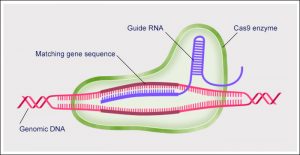In the science world new technologies are popping up almost daily. Some of these technologies will explode in scientific stardom, and others will go the way of the abacus. Today’s technology I will be talking about is a gene editing system called CRISPR/Cas9, which I’m certain is in the brink of exploding.
Sounds fancy, tell me more.
Originally, CRISPRs (Clustered Regularly Interspaced Short Palindromic Repeats) were isolated in the 1980s in bacteria1. It turns out they function as a defense mechanism against invading pathogens1. To make a long story short, bacteria can read pathogenic DNA and create a copy in the form of RNA2. This RNA template is called “guide RNA”2. A DNA cutting protein called Cas9 (CRISPR associated protein 9) can then utilize the guide RNA to selectively chop up the invading pathogen’s DNA2. In a lab setting, this selective chopping by the CRISPR/Cas9 system can be used to make extremely precise additions and deletions in virtually any organism (including humans)2
 .
.
The real kicker with CRISPRs is their ability to be wielded like a surgeons scalpel in the field of genetic engineering. Traditionally, scientists would have to go through generations of selective breeding before they would see any solid changes in an organisms genome. However, the machinery of CRISPR can make base specific edits in a genome using engineered guide RNAs. This bypasses years of breeding AND generates a much more reliable change in the DNA. The science sounds cool, but the applications are downright icy.
The most exciting aspect of CRISPR/Cas9 is its ability to fight cancer in a new way. Physicians could use CRISPR/Cas9 to supercharge a patients immune system in a way that would allow for the patient’s own body to target the cancer cells instead of painful chemo or radiation. I see a future where a cancer patient can take a few pills and be cancer free in days.
It sounds good, are there drawbacks?
A tool as powerful as CRIPR/Cas9 has the potential to do less than great things when used irresponsibly. One of the hottest topics in relation to CRISPR is the fear of so-called designer babies3. The idea is that fertility clinics could collect sperm and eggs of the parents, combine them to form a zygote, and then use CRISPR/Cas9 to essentially create a perfect baby that is free of any genetic disorders3. While this sounds good on paper, it leads us to my next question.
Where do we draw the line?
In the hypothetical designer baby situation, it would be possible to create a child that is stronger, faster, smarter, and bigger than any regular child. The service of creating such a child would probably come at a premium to the parents, thus excluding a large percentage of potential parents. In the long term, this could lead to an extreme gap between the wealthy elite super-humans and the regular non-super-humans. Now, this whole issue could be avoided if the public was informed about what CRISPR is and what it can do. If the public knew how powerful this tool was, there is no limit to the benefits that it could provide. So in conclusion, when CRISPR comes up in conversation in the coming years (which it will), please help move humanity forward by informing others of the greatness that is CRISPR.
Cited References
1Ishino Y, Shinagawa H, Makino K, Amemura M, Nakata A (December 1987). “Nucleotide sequence of the iap gene, responsible for alkaline phosphatase isozyme conversion in Escherichia coli, and identification of the gene product”. Journal of Bacteriology. 169(12): 5429–33.
2Hsu PD, Lander ES, Zhang F (June 2014). “Development and applications of CRISPR-Cas9 for genome engineering”. Cell. 157 (6): 1262-78
3Liang P, Xu Y, Zhang X, Ding C, Huang R, Zhang Z, Lv J, Xie X, Chen Y, Li Y, Sun Y, Bai Y, Songyang Z, Ma W, Zhou C, Huang J (May 2015). “CRISPR/Cas9-mediated gene editing in human tripronuclear zygotes”. Protein & Cell. 6 (5): 363–72.
This is fascinating. One question, though. What do you mean by “this could lead to an extreme gap between the wealthy elite super-humans and the regular non-super-humans. Now, this whole issue could be avoided if the public was informed about what CRISPR is”? Educating the public will not necessarily give them the funds to invest in this technology.
I really like the idea of bringing technological advances to the table as a theme for your blog. Technology is, as you allude to, expanding at an almost alarming rate. Good language in this first post – you do not make it sound super complicated, so good job relating to the general public. Anybody may access your blog at some point, so it’s important to keep your topics interesting and relatively easy to read. Good work!